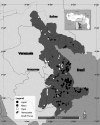Scorecard Approach to Eliminate Onchocerciasis in Venezuela
- PMID: 38861970
- PMCID: PMC11376111
- DOI: 10.4269/ajtmh.23-0743
Scorecard Approach to Eliminate Onchocerciasis in Venezuela
Abstract
In the Americas, onchocerciasis has been eliminated in 11 of 13 endemic foci by mass administration of ivermectin. The remaining at-risk population resides in a contiguous cross-border transmission zone located in the Amazon jungle in northwest Brazil and southern Venezuela, known as the Yanomami Focus Area. Here, we describe the development and implementation of a data-driven tool, called the Scorecard Approach (SCA), for the 393 communities that comprise the Venezuela South Focus. The SCA was first applied in 2018 and is reassessed on an annual basis. This operational strategy seeks to prioritize communities with low ivermectin coverage while taking into account the nature and variation of other epidemiological and logistical variables. Numeric scores are assigned for each factor and added together to yield a composite score for each community that is categorized as high, medium, or low priority. In this way, the SCA serves as a valuable and comprehensive strategy for planning, monitoring, and maximizing programmatic efficiency. In addition, it has allowed the country to face the main challenges of this endemic area: its remoteness, its large areas of territory to cover, the semi-nomadic nature of the Yanomami people, and their continuous cross-border movements. For 2022, the SCA categorized 54 (13.7%), 108 (27.5%), and 231 (58.8%) communities as high, medium, and low priority, respectively. The results presented here show that prioritizing communities at risk and with greatest needs increases the feasibility of interrupting the transmission of onchocerciasis by 2025 in the last endemic focus in the Americas.
Conflict of interest statement
Disclosures: The funders had no role in study design, data collection and analysis, decision to publish, or preparation of the manuscript.
Figures








References
-
- Duke BOL, 1990. Human onchocerciasis: An overview of the disease. Acta Leiden 59: 9–24. - PubMed
-
- WHO , 2020. Ending the Neglect to Attain the Sustainable Development Goals: A Road Map for Neglected Tropical Diseases 2021–2030. Geneva, Switzerland: World Health Organization. Available at: https://www.who.int/publications/i/item/9789240010352. Accessed August 25, 2023.
-
- Duke BOL, Zea-Flores G, Castro J, Cupp EW, Munoz B, 1991. Comparison of the effects of a single dose and four six-monthly doses of ivermectin on adult Onchocerca volvulus . Am J Trop Med Hyg 45: 132–137. - PubMed
-
- Cupp EW. et al. , 2004. The effects of long-term community-level treatment with ivermectin (Mectizan) on Onchocerca volvulus in Latin America. Am J Trop Med Hyg 71: 602–607. - PubMed
-
- World Health Organization , 2023. Progress in eliminating onchocerciasis in the WHO Region of the Americas: Advances towards interrupting the transmission of onchocerciasis from the latest preliminary serological assessments conducted in parts of the Yanomami Focus Area, 2018–2022. Wkly Epidemiol Rec 98: 453–457.
MeSH terms
Substances
LinkOut - more resources
Full Text Sources

